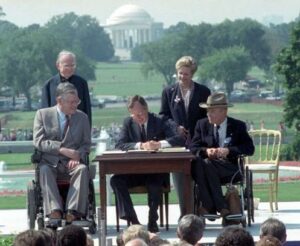Anniversaries offer a time for celebration. July 26 is a day of celebration for people with disabilities all over the world, as it is the day on which President George H.W. Bush signed the Americans with Disabilities Act. Anniversaries also offer a time for reflection. I am blessed to have many rich memories of July 26, 1990, as I was on the South Lawn of the White House with my wife, Joyce, my friend Mac, and more than three thousand colleagues.
When I reflect on that hot summer day thirty-three years ago, I recall the excited murmur and buzz among the sea of people crowded on the gentle hillside in front of the majestic South fountain, with the Jefferson Memorial in the background. I remember the collective roar from the voices of all those people when the Marine Band began to play Hail to the Chief. Then more cheers, and joyous yells, as President Bush, and the First Lady, Barbara. stepped outside the White House onto the lawn, and as they proceeded from the back of the crowd, all the way down to the podium and stage. I remember people crowding and leaning over one another to see the President or the First Lady, and to take photographs of them as they made the long walk to the stage. I remember the cheers when each one of the House and Senate Chief Sponsors of the ADA were acknowledged. And I can almost still feel the vibrations from the thunderous applause when the President introduced disability movement heroes Evan Kemp and Justin Dart, who were seated in their wheelchairs on either side of the desk where the President would sign the ADA Bill into law.

When National Council on Disability (NCD) Chairperson Sandra Parrino was introduced, I recall feeling very proud of my staff at NCD, Bob Burgdorf, Ethel Briggs, Andi Farbman, Kathy Roy and my other colleagues there, and of the Members of the NCD, all of whom worked together to conceive and nurture the ADA. As introductions and acknowledgments continued on the South Lawn stage, I drifted into memories of how we at NCD were flustered because no Members of Congress hastened to introduce an ADA Bill. And I thought about how wonderful it felt when our initial draft was introduced by Connecticut Senator Lowell Weicker, the parent of a child with a disability. I daydreamed about the huge reception we held in the Senate Office Building the night the Bill was introduced. I remembered how Members of Congress from both parties and both Houses climbed on stage with us and proclaimed the ADA would be our Civil Rights Act. I also recalled watching President George H.W. Bush on television the night before he was elected President promising, if he were elected, to assure equal opportunity for people with disabilities. I went on to recall how Bush, in his first address to Congress as President, said he intended to enact a disability rights law.
I was awakened from my reflections when the President said: “And now I lift my pen to sign …“As he spoke, mayhem followed every phrase. The President’s remarks were eloquent; they were perfect for the occasion … they were perfect for eternity. When the President talked about the walls of discrimination coming down, there was electricity in the air … the sheer joy in all our hearts was palpable. To be there at that moment was an experience I will always remember and cherish. I feel certain that everyone else who experienced that feels the same.
The ADA story, particularly the story of Thursday, July 26, 1990, is beautiful and compelling. We should celebrate every year, remembering the history, rededicating ourselves to the purpose, and recommitting ourselves to deliver on the promise of the ADA.
Hoorah! Long live the ADA! Forever protect the rights of people with disabilities!
Bonus Blurb, a bit of history: You may know that Iraq invaded Kuwait on August 2, 1990. What you may not know is that while White House Public Affairs staff in the Old Executive Office Building adjacent to the White House were making plans to host 3000 guests at the largest Signing Ceremony in history, other staff on another floor were monitoring reports of troop buildups in Iraq, Kuwait and Saudi Arabia.
They were also organizing U.S. troops and making contingency plans for prospective engagement in a Gulf War. If Kuwait had been invaded on the night of July 25, 1990, as some of the President’s advisors suggested they might, then ADA Day would most likely have been Gulf War Day – and the signing ceremony would have been canceled and rescheduled who knows when, or it would have been a small, quiet event in the Oval Office.
Either way, the promise of the ADA and the impact of a Page One, lead news story all over the world would have been lost.
The Americans with Disabilities Act (ADA) has impacted the lives of millions of individuals with disabilities. It ensures equal opportunities and prohibits discrimination, allowing for full participation in society. The ADA has led to opportunities for employment, education, and public events that were previously inaccessible for people with disabilities. It has helped to break down stereotypes and stigmas about disabilities, promoting a more inclusive and accepting society. The ADA has paved the way for advancements in accessibility technology and design, benefiting everyone in society. Upholding and enforcing the ADA is crucial to ensuring everyone can fully participate and contribute to society and as expressed annually – there is much more to be done to fulfill the promise of the ADA and ensure access for everyone.
This month’s blog is a reflection of the signing of the Americans with Disabilities Act, written by Lex Frieden, Convener of the National Advisory Board (NAB) on Improving Healthcare Services for Older Adults and People with Disabilities and Professor of Biomedical Informatics and Rehabilitation at the University of Texas.


